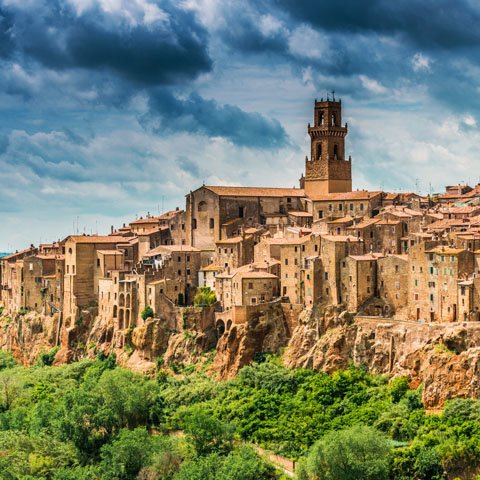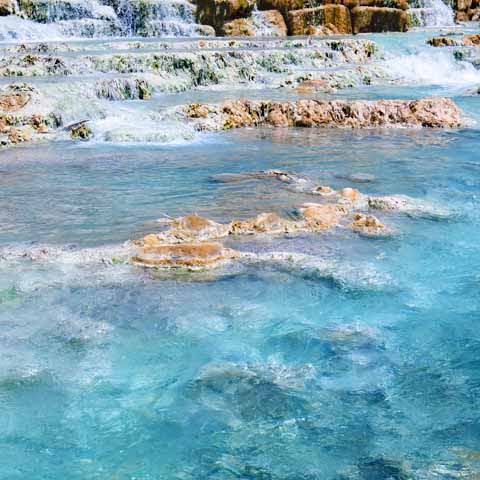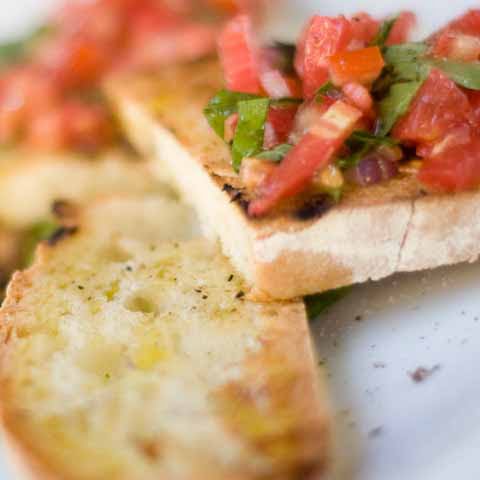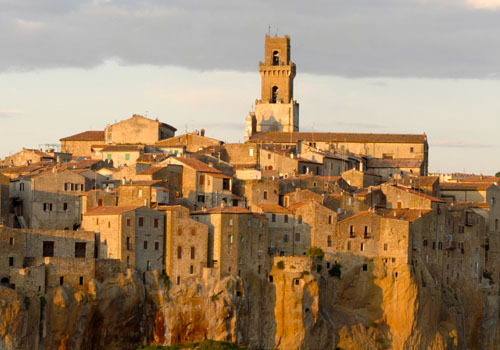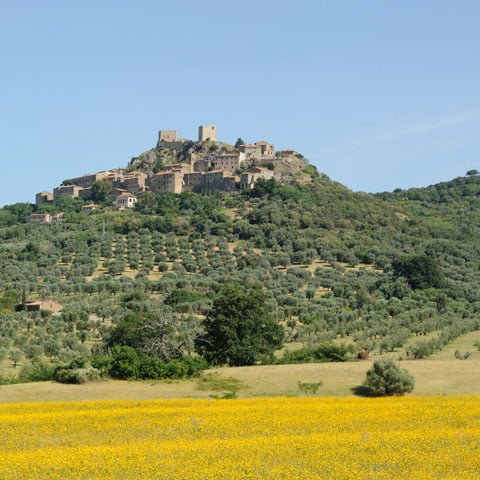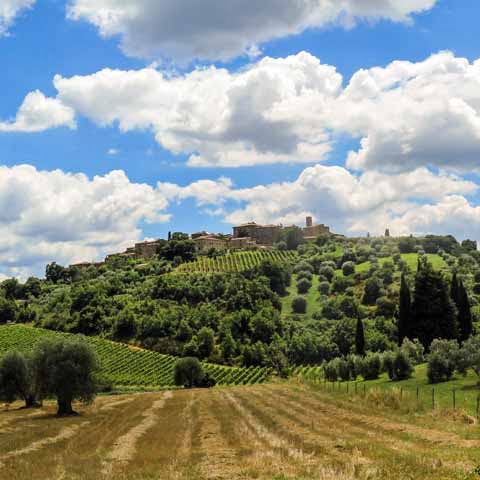Stretching across both the Grosseto and the Livorno provinces, the Maremma area has a history dating back millennia to well before Roman, and even Etruscan times. The earliest examples of civilization found in Maremma date back to the Bronze Age, and tools and even whole necropolises have been uncovered throughout the countryside from this period.
The region truly rose to prominence, however, with the growth of the Etruscans. The Etruscans greatly valued the Maremma region for its rich natural resources and, as a result, much of the major heart of their empire could be found in or near Maremma. The ancient Etruscans mined metal and precious stones in the area and traded them with other major civilizations at the time, such as the Greeks. Unfortunately, these resources would eventually be their undoing when the Roman Empire rose to prominence. Coveting these resources for themselves, the Romans defeated the Etruscans and ravaged their cities. To this day, little evidence remains to remember the Etruscans by, save for ruins such as those found in Roselle and Populonia.
After the fall of Rome, Maremma fell into a dark age that lasted for many centuries. The area had been so abused and stripped of its natural resources that it began to convert into a swampy marshland, a far cry from its previous rolling hills and forests. Disease and decay set in, including an infestation of malarial mosquitoes, and, for much of its history, Maremma was considered one of the poorest and harshest places on the Italian peninsula.
During the Middle Ages, the area was divided up between two prominent families; the Aldobrandeschi and Orsini families. Much of their influence can still be seen in the medieval towns that dot the countryside to this day, and, while they did their best to maintain their land and country, Maremma would eventually trade hands to the Spanish and Sienese Republic, who would go on to ravage and exploit the region for everything it was worth. The people of Maremma hated their foreign rulers, but were forced to put up with them for over 300 years before being liberated by Grand Duke Ferdinando III of Lorraine. Unfortunately, by that point, the malaria had spread so far and the land had become so inhospitable that most of the inhabitants of Maremma had either fled or died. Even Ferdinando III himself would eventually succumb to the disease.
It was only in the nineteenth century that the area was united and the story of the town began to take a turn towards the positive. Grand Duke Leopold II took up residence in the Maremma area’s town of Grosseto in 1828 and used hydraulic engineering techniques that were incredibly advanced for the time to drain the marshland that had formed after years of abusing the region for its resources. The land became fertile again, and the Maremmani began to flock back to their homes. However, this rise in wealth also gave way to a rise in banditry, including the fabled “Robin Hood of Italy,” named Domenico Tiburzi.
Nowadays, Maremma enjoys its own distinct culture in Italy. The people of Maremma enjoy their peaceful, rustic, country life, away from the hustle and bustle of larger Italian cities. In fact, the Maremmani are so dedicated to preserving their rustic way of life that many of the Maremmani scoff at the idea of even living in the capital of the region, Grosseto. A certain rivalry remains between the people of the capital and those who live out in the countryside, even though Grosseto is nowhere near as active a town as Florence, Rome, or any of the other main travel destinations in the country.
For now, the region has managed to retain many of its traditional rustic roots. The Maremmani have their own traditions, their own distinctive history, and their own dialect. Having successfully avoided the deluge of tourists that has fallen upon the rest of the nation, where it often seems that visitors to the country outnumber the natives 5 to 1, Maremma maintains and works hard to preserve much of its distinctive culture. This is seen perhaps most notably in the form of the butteri. The butteri (sing. buttero) are perhaps best known colloquially as ‘Italian Cowboys,’ and work on the open fields and ranges of Maremma’s grasslands, herding cattle and working with livestock. While today they number less than a hundred, the tradition is still kept alive and visitors to the area can go riding with them and get a sense of the type of honest, country life the Maremmani cherish.
ART
The Maremma region is not as well known for its art and architecture as much of the rest of Italy. While the Aldobrandeschi and Orsini families managed to help shepherd the region through much of the Middle Ages, the area was far less affected by the Italian Renaissance due to the rampant disease and the ravaging the region took from the Spanish.
However, due to its roots in the Etruscan period, there is a heavy emphasis on archaeology in the Maremma region, which has unearthed some interesting artistic finds from the Middle Ages and beyond. Travelers to the area should make an effort to visit the Museo Archeologico e d’Arte della Maremma in Grosseto. Here, visitors can view over 40 rooms filled with a variety of ancient findings, such as Etruscan urns painted with pictographs, Roman statues, Ancient Latin inscriptions, and even Bronze-age tools left behind by the area’s very first settlers.
Additionally, there is another archaeological museum in the Maremma town of Pitigliano. The collection in Pitigliano features artifacts from the seventh to the sixth centuries BC that were uncovered in Pitigliano and at the Poggio Buco necropolis. On display are ceramics, urns, and historic decorations.
While the Renaissance may have largely passed the Maremma region by, there are still monuments to the period in the area for visitors to see. The Museo di Arte Sacra della Diocesi in Grosseto can be found right alongside the aforementioned Archaeology Museum in the Palazzo del Vecchio Tribunale in Grosseto’s main piazza. Here, many of the few Renaissance pieces from Maremma that have been found and collected from the scattered Maremmani churches and palazzi are gathered, along with other Renaissance and religious pieces from other areas of Italy.
ARCHITECTURE
While the ostentatious Renaissance architecture that is found in so many other Italian cities is mostly absent from the Maremma area, much of the medieval architecture that was constructed during the rule of the Aldobrandeschi and Orsini families remains in the towns that dot Maremma’s landscape. Whether you visit Grosseto, Capalbio, Pitigliano, Sovana, or Sorano, the architecture of the towns is largely medieval in origin.
Sorano, for example, still has massive, medieval city walls, complete with towers and impressive gateways. Sorano also hosts the Orsini Fortress, which was built by the Aldobrandeschi family and then purchased and expanded by the Orsini family. The Orsini Fortress also contains its own Museum of Medieval Culture.
Sovana, meanwhile, contains the Chiesa di Santa Maria Maggiore. Though this church might not seem impressive compared to many of the Chapels, Duomos, and Basilicas found throughout Italy, it is notable for being perhaps the oldest church in Tuscany, and travelers with a talented eye for architecture will still find several curiosities about the fourth century church.
Also in Sovana is the Aldobrandesca Fortress, which was built by the Aldobrandeschi family. Dating back to the eleventh century, the fortress, which is attached to the town’s defensive walls, features a fortified tower. A church not to be missed in Sovana is the Cathedral of San Pietro, which is said to mark the transition from the Romanesque style of architecture to the Gothic stye.
Perhaps the single most interesting example of still-standing architecture found in the Maremma region, however, is the Cathedral of San Lorenzo found in Grosseto. This late-medieval church was restored and reworked in the Renaissance and Baroque periods, with the result being an interesting mix of the three architectural styles. The façade features ornate doors and archways, with a massively impressive rose window above the entryway and a belltower that was added to its left wall during the early Renaissance.
Another religious structure dedicated to San Lorenzo is in Civitella Paganico, located between Grosseto and Siena. The monastery dates back to the twelfth century and was founded by the Ardengheschi family. It is considered to be among the best examples of Romanesque architecture in the Maremma area.
For those visitors more interested in something truly ancient, though, the ruins at Roselle are a recommended visit. These vast Etruscan ruins can be found not too far outside of Grosseto, and can give visitors a sense of what life was like in the far ancient past.
LITERATURE
Though Maremma itself does not have a particularly extensive tradition of literature, authors from other parts of Italy have written on the area extensively. Dante Alighieri, the very same author of the Divine Comedy, wrote extensively upon the area of Maremma, though unfortunately his poetry is hardly charitable due to the area being mostly malarial swampland at the time.
MUSIC
Maremma plays host to multiple annual music festivals. Perhaps the most notable examples include Festambiente and the Bolgheri Melody. There are also many concerts held throughout the year at the Teatro delle Rocce di Gavorrano and the Cava di Roselle.
CINEMA
The Maremma area’s most notable appearance on the big screen was in Quantum of Solace (2008), which features a scene filmed at the Talamonaccio Tower along the coast of the Gulf of Talamone. Maremma was also featured briefly in The Talented Mr. Ripley (1999) and Academy Award-winner La grande bellezza (2013).
Additionally, several Italian movies have been set or shot in the area including Non ci resta che piangere (1984), Giochi d’estate (2011), Manuale d’amore 3 (2011), and Loro (2018).
SCIENCE
While Maremma is a region that mostly focuses on maintaining its honest, rustic lifestyle, that is not to say that there is no sense of science or higher learning in the area. In Grosseto, one can find the Museo di Storia Naturale della Maremma. This Natural History museum highlights much of the geology and geography of the Maremma area, helping visitors learn about the many natural resources of the region, as well as how the land formed from volcanic tuff rock. The museum also explores and catalogues the species of flora and fauna native to the region through dioramas and interactive multimedia workstations.
Don't just see Italy, live it.
Your dream trip to Italy has never been closer
No more endlessly scrolling travel sites. Our travel experts will craft the perfect, one-of-a-kind trip just for you.

300+
DESTINATIONS
We offer more Italian destinations than any travel site. Do and see more with Trips 2 Italy.
1 (of a kind)
ITINERARIES
Because your dream trip to Italy should be designed for you, not for the masses.
100%
PEACE OF MIND
From flights and accommodations, to food and activities - we take care of every detail.
